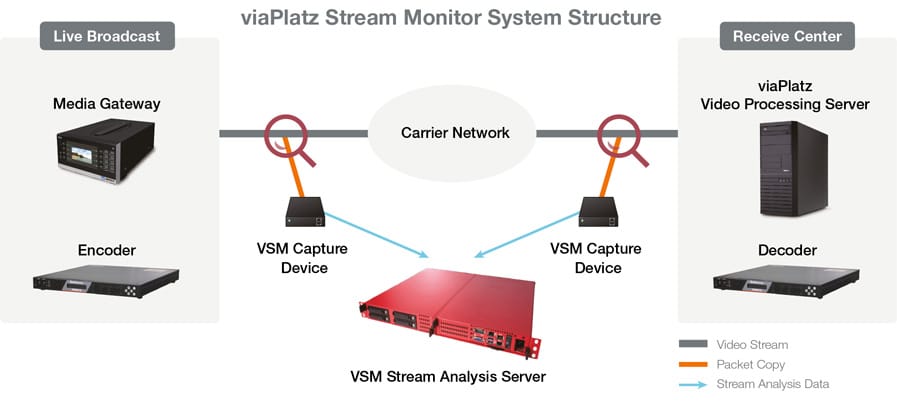NTT-TX improves analysis of
high-quality 4K/8K video streams
Case Study
ENTERING A NEW ERA OF IP-BASED HIGH-QUALITY VIDEOS
As high-speed network infrastructure installation and video compression technologies progress, the need for IP-based high-quality video transmission is increasing more than ever. Transmitting IP-based video and voice over networks is considered less expensive and more flexible than transmitting over a dedicated line or a satellite link.
Continuous efforts have been made to put IP-based 8K high-resolution video transmission into practical use. During the 2014 FIFA World Cup, a public viewing event was held in Japan by transmitting IP-based 8K high-resolution videos from Brazil to Japan. In February of 2015, the National Institute of Information and Communications Technology (NICT) successfully demonstrated transmission of uncompressed 8K videos to multiple locations over 100 Gbps multicast networks.
CHALLENGE
Quality failure could potentially become a serious issue when it comes to transmitting videos on a commercial basis. It is not feasible for a video transmission service enterprise to single-handedly prepare the entire network connecting to each of the transmission sites. If a quality failure were to take place within a carrier network, it would be extremely difficult to determine the cause of such a failure. Video quality failures may be prevented by the use of forward error correction (FEC) and/or redundant multiple transmission networks. However, this will require a large amount of human resources to continuously monitor videos to optimize the FEC parameter settings and routings. Naturally, such monitoring costs will escalate as the number of video streams increases and the network structure becomes more complex.
SOLUTION
viaPlatz Stream Monitor (VSM) is a system designed to overcome the IP-based video transmission challenges. By installing a VSM capture device at each of the sites within the network, the system GUI will make it possible to monitor the health status of all streams, obtain quality information for FEC purposes, and identify the problem points. When, for instance, a live broadcast video transmission is planned over a carrier network, a VSM device can be installed at either end of the carrier network to enable monitoring of both the upstream and the downstream health status of the video streams.
ANALYZE UNCOMPRESSED 8K VIDEO STREAMS
The stream analysis server integrates the information collected from all VSM devices, and monitors the health status of each video stream. If a problem occurs, the server will investigate the problem point and immediately display the status on the GUI monitor. The detailed GUI functions with charts include information on bit rate (in the order of microseconds) packet loss, burst packet loss, reorder, duplication and jitter of each video stream. VSM complies with RTP (standard protocol for video transmission) and MMT (new protocol), and is capable of analyzing video streams ranging from compressed to uncompressed HD, 4K and 8K.
Identifying video streams and calculating the status using VSM devices based on standard NICs puts a heavy load on the CPUs. This is because all the packets for which the header information is to be retrieved must be received and the packet matching must be done before the processing stream analysis. As the number of streams and the bandwidth increase, the load on CPU and memory will also increase. Consequently, investments in faster CPUs and memories capable of handling such processes are required to prevent packet loss.
BENEFITS FROM USING NAPATECH SMARTNICS
GUARANTEED FULL LINE-RATE PACKET CAPTURE WITH ALMOST NO CPU LOAD
By running viaPlatz Stream Monitor on Napatech’s FPGA-based SmartNICs, only the header data is sent to the CPU cache memory for analysis. The load on the CPUs that used to be required for stream identification can now be taken over by Napatech FPGA SmartNICs, so the cost of CPU and memory required for VSM can be kept low even when the broadband networks are progressing from 10G to 40G and 100G.
Transmission device network interfaces range from 1 to 100G, and call for either copper or fiber, depending on the given environment. Napatech FPGA SmartNICs are compatible with a variety of interfaces, and their common API facilitates application development.
Another key benefit of running VSM devices on Napatech FPGA SmartNICs is the timestamp accuracy. High precision packet reception time information is essential for a VSM device to check for bursts and measure jitter. In a system utilizing a standard NIC, packet reception time-stamping is done by the operating system once the reception process is complete, and thus the timing for stamping can vary depending on the CPU loads.
As Napatech FPGA SmartNICs add a hardware timestamp with nanosecond precision, they can obtain accurate reception time information regardless of CPU load. In combination with external synchronization signals such as PTP and GPS, it is possible to synch two or more Napatech FPGA SmartNICs. This function makes it possible to precisely compare measurements of the same stream obtained from different sites equipped with VSM devices.

